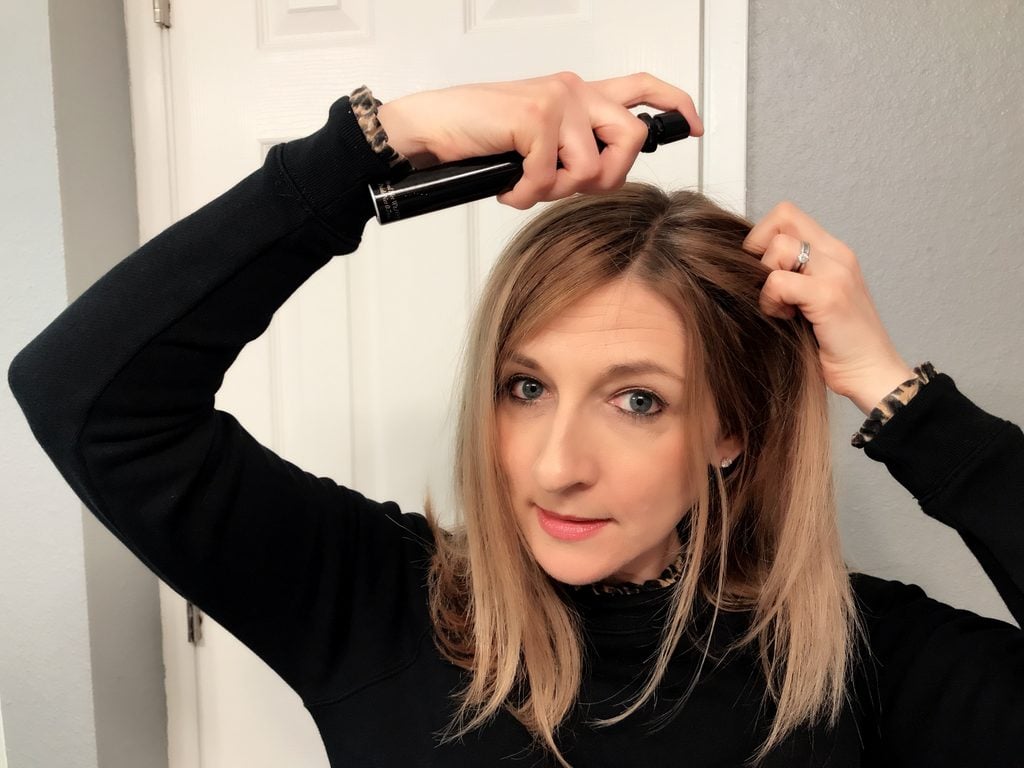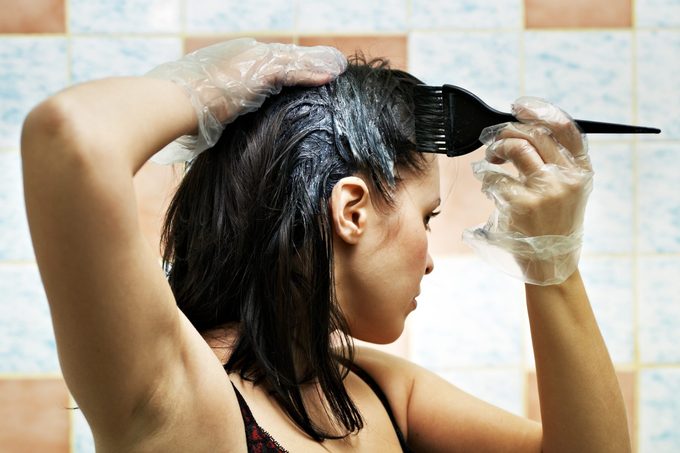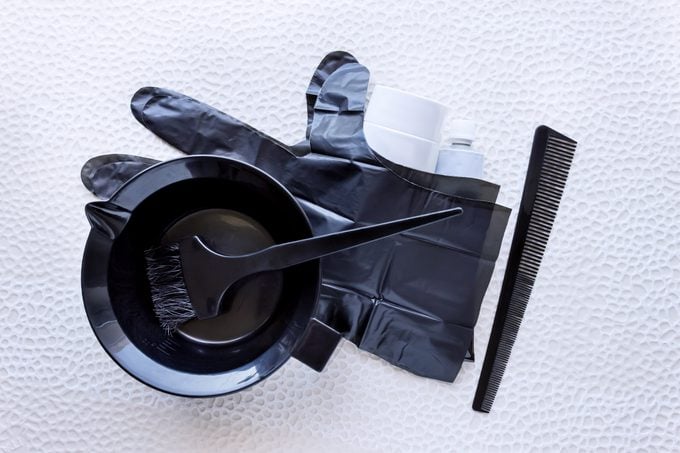Why I’m Not Coloring My Own Hair During Quarantine—And You Shouldn’t Either
Updated: Feb. 14, 2023

DIY hair color is a disaster waiting to happen.
Usually, I am at the hair salon every four to five weeks for color and highlights. I book my appointments months in advance, and I arrange my family’s calendar to accommodate this non-negotiable date with my stylist. In the eight years, I’ve been coloring my hair consistently, I’ve never missed an appointment over anything other than my stylist having the flu.
Until now, that is. My stylist, like nearly every other stylist in the nation, has closed up shop while we wait out the worst of the novel coronavirus. A wise—and in most states, required—move, but one that leaves those of us with high-maintenance hair routines wondering what we can do in the interim to deal with unsightly regrowth, the unwelcome emergence of gray, and the overall lack of luster in our tresses. In case you’re wondering, here are the best haircuts for your face shape.
Is DIY color an option?
Some hair-color devotees, even those who have never self-colored their hair before, seem to think so—at least according to the numbers. Madison Reed, a company that specializes in an at-home color that is free of ammonia, parabens, and resorcinol, says new top-line growth has increased 12-fold since March 5. (One of its new converts is fashion designer Rebecca Minkoff, the company noted in an email.) Same goes for Naturtint, another popular ammonia-free brand.
“We [have had] an increase in our online orders, with overall sales up over 20 percent,” says Ashley Boice, Naturtint USA’s executive director. “Our customer support team is receiving lots of inquiries from new customers seeking guidance on how to color their hair at home, and we are happily assisting and educating.” This is right in line with recent data released by Nielsen. The global market research firm reported that, as of the week ending March 21, direct-to-consumer hair-color sales were up 19.4 percent over the same week last year, according to NPR.
Professional stylists, on the other hand, are urging their clients to step away from the boxed color and either: a) live with the regrowth and grays for a while, or b) find alternative/non-damaging ways to camouflage those roots. While I am definitely not a fan of how my hair is looking at the moment, this is the advice I’ll be taking, and not just because it’s tricky to find exactly the right hair color for my skin tone. Here’s why I’m refusing to color my own hair during quarantine—and why you, too, should remove the boxed hair dye from your online shopping cart.
Boxed color can damage your hair
While they often make it look easy, professionals use a precise combination of art and science to create custom formulas that are suited to the texture and color of each individual client’s hair. When they apply it, they have a pretty good idea of how the hair in question will respond.
When we grab a box of color from a shelf and apply it to our previously colored hair, we really have no idea what will happen because we aren’t schooled in the chemistry that is involved in the process, explains Bettina Schupp, vice president of brand development for Goldwell/KMS, a professional color and product line. Will hair become dry and brittle? It might, especially if you’re haphazardly applying a bleaching product on top of already-bleached hair. “If you use bleaching products, you might damage your hair so dramatically that your only option is to cut it,” Schupp explains.
Will your hair turn orange? Yes, this is entirely possible. Will it stick around, even if the box says it will wash out in 10 shampoos? Also, likely. Plus, the box doesn’t say how much ammonia is in the product; as a result, you might be applying far more ammonia than is necessary to get the job done, and that can be very damaging. While ammonia isn’t necessarily a bad thing—professional hair color typically contains ammonia as well, since this is what allows the color to bind to your hair—too much ammonia can be a problem. “People need different levels of ammonia, or even ammonia-free [dye], depending on their desired results,” says my current stylist, Chelsie Caudle of Grace Salon in Portland, Oregon.
Oh, and did you know that hair dye can be sold without FDA approval? This makes it tough (if not impossible) for customers to verify the accuracy of the product information printed on the packaging. “They can say whatever they want on the box,” says Daria Daniel, Goldwell color educator and owner of Urbaca Salon in Portland, Oregon. “And this is not fair to the consumers because they are believing what they are reading.”
So, to reiterate, we’re talking about the possibility of excess ammonia, inaccurate claims on the packaging, a random formula that does who-knows-what to hair, and the probability that it won’t wash out when it claims it will? Next!
Color-treated hair requires extra special care. Make sure you know these 9 color mistakes that could completely ruin your hair.
The results will likely be disappointing (if not awful)

Even if you manage to find store-bought color that doesn’t leave your hair dry, brittle, and/or orange, the color you see on the box is not the color you are going to see in your hair (there are rare exceptions, but don’t count on being one of them), and you will ruin the color your stylist has worked so hard to achieve. Plus, there’s a lot more that can potentially go wrong.
For one thing, your hair is unique in how it responds to color—no matter what the box (or the friendly person on the phone) tells you. “People can have similar colors [in their hair], but that doesn’t mean I am using the exact same formula to get them there,” says Felicia Dosso, a junior colorist at Nunzio Saviano Salon on Manhattan’s Upper East Side. “It depends on what their natural color is.”
Hair texture is a concern, as well. “Someone with fine hair versus someone with coarse hair will get a completely different result, even if they use the same color,” explains Caudle.
Then there’s the issue of application. Again, just because professionals make it look easy, it doesn’t mean it is easy. The color needs to be applied using specific techniques (techniques your stylist learned by attending hours and hours of continuing education), and these techniques can vary—not just by person but by each section of hair. When you DIY, it looks a little funny. “It is really hard to see the back of your head,” Caudle says. “Chances are, you will miss spots and get a patchy end result.”
Even Daniel, who has been coloring hair for more than 30 years, is waiting it out. “I cannot color my own hair properly, either,” she says.
Correcting mishaps will cost a small fortune
Between color, highlights, haircuts, products, and tools, I’ve invested a lot of money into my hair over the years. I don’t regret a single penny. I would regret spending $8 on a box of hair color from Target or Amazon, however, because once you factor in the high price of professional color correction, that $8 box of hair color actually costs much, much more.
“You are going to spend a ton more money because it is going to take the stylist a long time to fix it,” Daniel says. How long? It depends, but in some cases, it can take multiple appointments to fix home hair color gone wrong, says Dosso.
The exact cost depends on several factors (like the overall condition of your hair, as well as where you live), but Daniel says you should expect a color correction to set you back around $100 per hour. So, let’s say the worst-case scenario is that you need three two-hour appointments to get your color looking good again. That’s $600—all because of an $8 box of hair color and the need for instant color gratification. Wouldn’t you rather spend that money on a few regular hair appointments when this is all over? I would!
Plenty of safe alternatives exist
Fortunately, avoiding boxed hair dye is not synonymous with doing nothing. You can still cover up regrowth and gray hair with temporary products that easily wash out every time you shampoo. I personally love root sprays. Oribe’s Airbrush Root Touch-Up Spray is my favorite. I started using it in between color sessions long before we were all quarantined to our respective residences. And the pros love it, too—every expert I spoke to for this story recommends it.
Other cover-up options include L’Oréal Professional Root Touch-Up Concealer and Goldwell’s DualSenses Color Revive Root Touch-Up Powder. This might even be a great time to experiment with whimsical color in the forms of chalks or sprays. Splat Hair Color, for example, makes a 100 percent vegan hair chalk that comes in colors like mint candy, purple pixies, and pink hearts. (The chalk “slides” on, according to the company’s website, and easily washes out.)
Another option? Accessories! “If you need to go out, put on a hat,” Caudle says. To pick a flattering one, check out this guide to finding the perfect hat for your face shape.
If you must…

And if you still feel compelled to do something more? Some stylists, including Dosso, are offering at-home color kits (which include custom formulas and application instructions) to their clients during the quarantine. “I understand that right now, people are on Zoom and seeing their roots is driving them crazy,” she says. “So I don’t mind if they do their hair at home if they must, but I would rather [they] use my formula so at least the tone will be the same.”
For me, though, this is still risky business. In other words, I don’t trust myself—even with the right formula. I’ll be sticking to my root sprays and powders because I am sure that any DIY attempt on my part would result in something disastrous. My stylist concurs. “The color kits are much better than a store-bought box if they’re coming from your own stylist,” Caudle says. “But my personal issue with this is: Are you going to apply the color correctly in a five-minute crash course from your stylist? Probably not.”
Besides, you might find that your hair is rising to the occasion on its own. My hair has certainly seen better days, but it doesn’t look nearly as unkempt as I’d anticipated. When I do finally get to sit down in the salon chair again? Who knows—maybe I’ll be ready to try a fun new color or (gasp!) embrace the gray streaks I’ve been battling for the past couple of years. Or maybe I’ll just stick with my reliable base color and dimensional blond highlights. In any case, I’ll be glad I waited—and you will be glad you waited, too.
After your next appointment, try these 14 stylist-approved tricks to make your hair color last longer.